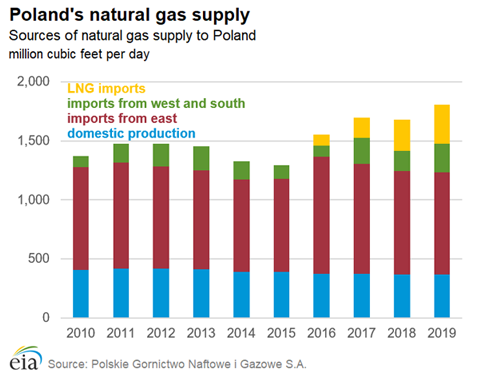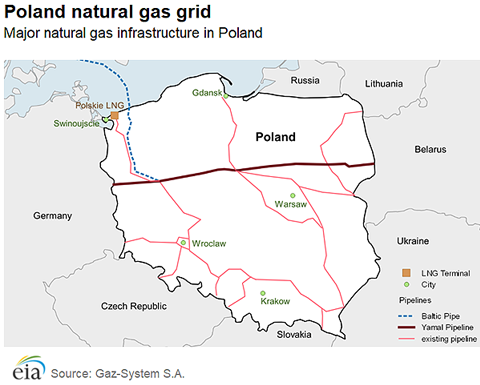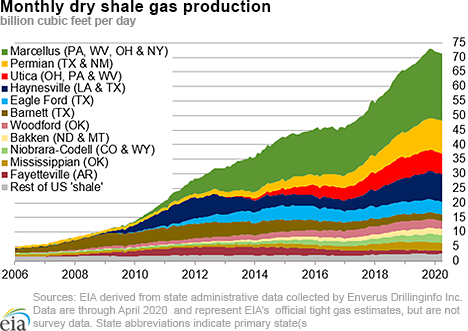In the News:
Poland seeks to diversify natural gas imports
Facing a continuing decline in domestic natural gas production and the expiration of Russian pipeline import contracts, Poland continues to diversify its imports by expanding connectivity to both the west and the south. On May 7, 2020, a major pipeline project—the Baltic Pipe—connecting the Polish natural gas grid with natural gas supply from Norway through Denmark, secured construction permits through Sweden’s territorial waters, the last such permit required before construction work can begin. The pipeline will have nearly 1 billion cubic feet per day (Bcf/d) of capacity and is planned to be commissioned in October 2022.
Domestic natural gas production in Poland has been declining over the past 10 years, falling to 0.4 Bcf/d (20% of the total natural gas supply) in 2019. Natural gas consumption, however, has grown by more than 30% over this period—from 1.4 Bcf/d in 2010 to 1.8 Bcf/d in 2019—as Poland’s main utilities expanded the domestic network and connected more industrial, residential, and commercial consumers to the natural gas grid. Since 2010, Polish utilities have added more than 13,000 miles of domestic distribution and trunk lines and maintained nearly 3% annual growth in domestic connections, according to Statistics Poland.
Rising domestic consumption and a decline in domestic production resulted in an increasing reliance on natural gas imports. Communist-era legacy pipeline connections were designed for closer integration with eastern supply, and as recently as 2010, natural gas imported from the east—primarily from Russia—accounted for 90% of imports and more than 63% of all supply. By 2019, however, volumes of natural gas imported from the east fell to 60% of all imports and 48% of the total consumption.
As a result of the recent expiration of the Yamal-pipeline transit agreement on May 17 and the forthcoming expiration of the long-term natural gas supply contract on December 31, 2022, between Gazprom (Russia’s state-run natural gas company) and Polskie Gornictwo Naftowe i Gazowe (PGNiG) (the main wholesale supplier of natural gas in Poland), diversification efforts in Poland continue at a rapid pace.
Pipeline imports from the west and south through newly established interconnectors with Germany, the Czech Republic, and Slovakia, increased from 97 million cubic feet per day (MMcf/d) in 2010 to 242 MMcf/d in 2019. In 2016, Poland also began importing liquefied natural gas (LNG) at the Polskie LNG terminal in Świnoujście, located on the Baltic Sea near the Polish-German border. LNG imports have grown from 94 MMcf/d in 2016 to 331 MMcf/d in 2019, contributing 18% to the total supply in 2019. Work to expand the 0.5 Bcf/d LNG terminal by 50% is slated for completion by late 2021.
Overview:
(For the week ending Wednesday, May 20, 2020)
- Natural gas spot prices rose at most locations this report week (Wednesday, May 13 to Wednesday, May 20). The Henry Hub spot price rose from $1.56 per million British thermal units (MMBtu) last Wednesday to $1.83/MMBtu yesterday.
- At the New York Mercantile Exchange (Nymex), the price of the June 2020 contract increased 16¢, from $1.616/MMBtu last Wednesday to $1.771/MMBtu yesterday. The price of the 12-month strip averaging June 2020 through May 2021 futures contracts climbed 4¢/MMBtu to $2.399/MMBtu.
- The net injections to working gas totaled 81 billion cubic feet (Bcf) for the week ending May 15. Working natural gas stocks totaled 2,503 Bcf, which is 45% more than the year-ago level and 19% more than the five-year (2015–19) average for this week.
- The natural gas plant liquids composite price at Mont Belvieu, Texas, rose by 52¢/MMBtu, averaging $4.27/MMBtu for the week ending May 20. The prices of natural gasoline and ethane rose by 8% and 18%, respectively. The prices of propane, butane, and isobutene each rose by 13%. Ethane prices continue to rise above their long-term trend of value relative to natural gas amid concerns about declining liquids-rich natural gas production in the Permian Basin and its impacts on availability of ethane as a petrochemical feedstock.
- According to Baker Hughes, for the week ending Tuesday, May 12, the natural gas rig count decreased by 1 to 79. The number of oil-directed rigs fell by 34 to 258. The total rig count decreased by 35, and it now stands at 339, the lowest on record dating back to 1987.
Prices/Supply/Demand:
Prices rise at most locations across the Lower 48 states. This report week (Wednesday, May 13 to Wednesday, May 20), the Henry Hub spot price rose 27¢ from a low of $1.56/MMBtu last Wednesday to a high of $1.83/MMBtu yesterday. Temperatures were generally close to normal, with cooler-than-normal temperatures in California and the Midwest. At the Chicago Citygate, the price increased 21¢ from $1.54/MMBtu last Wednesday to $1.75/MMBtu yesterday.
TETCO announces a return to service date on part of its system following a May 4 explosion. On May 4, Enbridge Inc. reported an explosion on Line 10 of its 30-inch pipeline segment of its Texas Eastern Transmission (TETCO) system near the Owingsville Compressor Station, 50 miles east of Lexington, Kentucky. Three lines transport natural gas through this area: Lines 10, 15, and 25. Line 25, which has a capacity of 0.8 Bcf/d, is expected to return to service between May 22 and 24.
California prices rise. The price at PG&E Citygate in Northern California rose 13¢, up from $2.50/MMBtu last Wednesday to a high of $2.63/MMBtu yesterday. The price at SoCal Citygate in Southern California increased 13¢ from $1.70/MMBtu last Wednesday to $1.83/MMBtu yesterday.
Northeast prices rise. At the Transcontinental Pipeline Zone 6 trading point for New York City, the price increased 18¢ from $1.26/MMBtu last Wednesday to $1.44/MMBtu yesterday after hitting a low of $1.03/MMBtu on Thursday. At the Algonquin Citygate, which serves Boston-area consumers, the price went up 20¢ from $1.23/MMBtu last Wednesday to $1.43/MMBtu yesterday after hitting a low of $1.06/MMBtu on Thursday.
The Tennessee Zone 4 Marcellus spot price increased 20¢ from $1.07/MMBtu last Wednesday to $1.27/MMBtu yesterday. The price at Dominion South in southwest Pennsylvania rose 19¢ from $1.18/MMBtu last Wednesday to $1.37/MMBtu yesterday.
Permian Basin discount to the Henry Hub narrows. The price at the Waha Hub in West Texas, which is located near Permian Basin production activities, averaged a low of $1.38/MMBtu last Wednesday, 18¢/MMBtu lower than the Henry Hub price. Yesterday, the price at the Waha Hub averaged a high of $1.71/MMBtu, 12¢/MMBtu lower than the Henry Hub price.
Supply declines as natural gas production falls. According to data from IHS Markit, the average total supply of natural gas fell by 1.9% compared with the previous report week. Dry natural gas production decreased by 2.1% compared with the previous report week. Average net imports from Canada increased by 1.0% from last week. According to reports, EQT Corporation, the largest natural gas producer in the United States, announced on Tuesday it started reducing production in Pennsylvania and Ohio on May 16 as a result of lower demand and prices.
Demand falls, driven by low heating demand in buildings. Total U.S. consumption of natural gas fell by 10.0% compared with the previous report week, according to data from IHS Markit. Gains in the electric power sector were more than offset by low demand for heating in buildings because of seasonal spring temperatures. In the residential and commercial sectors, consumption declined by 40.8% after a cold snap last week that increased heating demand. Industrial sector consumption decreased by 3.8% week over week. Natural gas consumed for power generation climbed by 11.3% week over week. Natural gas exports to Mexico increased 2.5%.
U.S. LNG exports decrease week over week. Ten liquefied natural gas (LNG) vessels (four from Sabine Pass, three from Cameron, and one each from Freeport, Corpus Christi, and Cove Point) with a combined LNG-carrying capacity of 37 Bcf departed the United States between May 14, 2020, and May 20, 2020, according to shipping data provided by Marine Traffic. This export volume is the lowest since the week of October 17, 2019.
Storage:
The net injections into storage totaled 81 Bcf for the week ending May 15, compared with the five-year (2015–19) average net injections of 87 Bcf and last year's net injections of 101 Bcf during the same week. Working natural gas stocks totaled 2,503 Bcf, which is 407 Bcf more than the five-year average and 779 Bcf more than last year at this time.
According to The Desk survey of natural gas analysts, estimates of the weekly net change to working natural gas stocks ranged from net injections of 73 Bcf to 91 Bcf, with a median estimate of 83 Bcf.
More storage data and analysis can be found on the Natural Gas Storage Dashboard and the Weekly Natural Gas Storage Report.
See also:
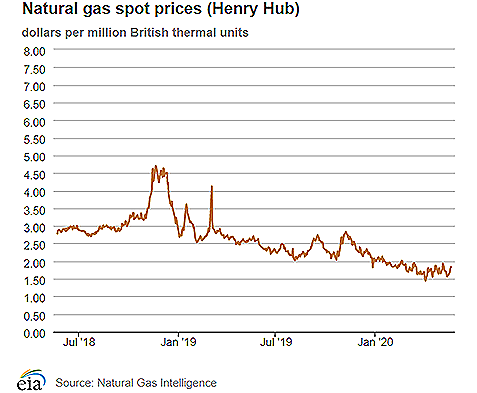
| Spot Prices ($/MMBtu) | Thu, 14-May |
Fri, 15-May |
Mon, 18-May |
Tue, 19-May |
Wed, 20-May |
|---|---|---|---|---|---|
| Henry Hub |
1.59 |
1.60 |
1.69 |
1.80 |
1.83 |
| New York |
1.03 |
1.11 |
1.60 |
1.48 |
1.44 |
| Chicago |
1.51 |
1.56 |
1.70 |
1.76 |
1.75 |
| Cal. Comp. Avg.* |
1.79 |
1.80 |
1.95 |
2.01 |
2.00 |
| Futures ($/MMBtu) | |||||
| June contract | 1.681 |
1.646 |
1.783 |
1.830 |
1.771 |
| July contract |
1.884 |
1.833 |
1.959 |
1.985 |
1.909 |
| *Avg. of NGI's reported prices for: Malin, PG&E Citygate, and Southern California Border Avg. | |||||
| Source: NGI's Daily Gas Price Index | |||||
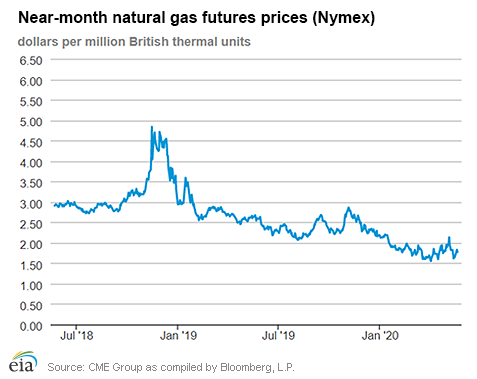
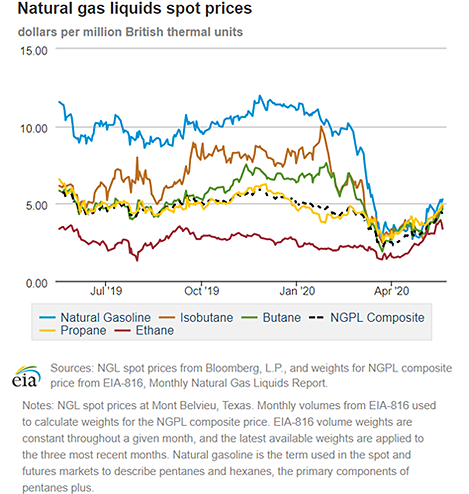
| U.S. natural gas supply - Gas Week: (5/14/20 - 5/20/20) | |||
|---|---|---|---|
Average daily values (Bcf/d): |
|||
this week |
last week |
last year |
|
| Marketed production | 101.1 |
103.3 |
100.1 |
| Dry production | 89.9 |
91.8 |
88.5 |
| Net Canada imports | 4.2 |
4.2 |
4.4 |
| LNG pipeline deliveries | 0.1 |
0.1 |
0.1 |
| Total supply | 94.2 |
96.1 |
92.9 |
|
Source: IHS Markit | |||
| U.S. natural gas consumption - Gas Week: (5/14/20 - 5/20/20) | |||
|---|---|---|---|
Average daily values (Bcf/d): |
|||
this week |
last week |
last year |
|
| U.S. consumption | 60.5 |
67.3 |
60.1 |
| Power | 26.8 |
24.1 |
26.1 |
| Industrial | 21.2 |
22.0 |
21.7 |
| Residential/commercial | 12.5 |
21.2 |
12.3 |
| Mexico exports | 4.8 |
4.7 |
4.7 |
| Pipeline fuel use/losses | 6.0 |
6.2 |
6.0 |
| LNG pipeline receipts | 6.2 |
7.1 |
5.7 |
| Total demand | 77.6 |
85.2 |
76.5 |
|
Source: IHS Markit | |||
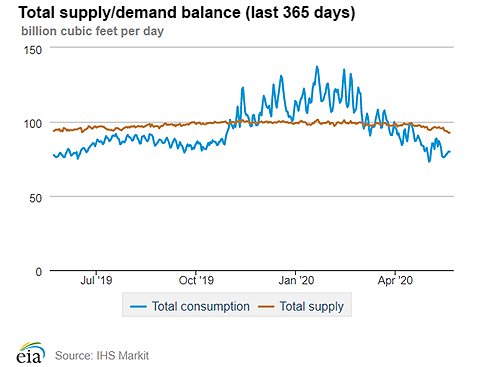
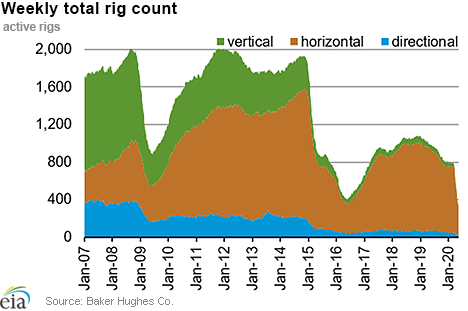
| Rigs | |||
|---|---|---|---|
Tue, May 12, 2020 |
Change from |
||
last week |
last year |
||
| Oil rigs | 258 |
-11.6% |
-67.8% |
| Natural gas rigs | 79 |
-1.3% |
-57.3% |
| Note: Excludes any miscellaneous rigs | |||
| Rig numbers by type | |||
|---|---|---|---|
Tue, May 12, 2020 |
Change from |
||
last week |
last year |
||
| Vertical | 10 |
11.1% |
-79.2% |
| Horizontal | 307 |
-9.2% |
-64.5% |
| Directional | 22 |
-18.5% |
-69.9% |
| Source: Baker Hughes Co. | |||
| Working gas in underground storage | ||||
|---|---|---|---|---|
Stocks billion cubic feet (Bcf) |
||||
| Region | 2020-05-15 |
2020-05-08 |
change |
|
| East | 469 |
452 |
17 |
|
| Midwest | 576 |
554 |
22 |
|
| Mountain | 124 |
117 |
7 |
|
| Pacific | 253 |
240 |
13 |
|
| South Central | 1,081 |
1,059 |
22 |
|
| Total | 2,503 |
2,422 |
81 |
|
|
Source: Form EIA-912, Weekly Underground Natural Gas Storage Report | ||||
| Working gas in underground storage | |||||
|---|---|---|---|---|---|
Historical comparisons |
|||||
Year ago (5/15/19) |
5-year average (2015-2019) |
||||
| Region | Stocks (Bcf) |
% change |
Stocks (Bcf) |
% change |
|
| East | 346 |
35.5 |
376 |
24.7 |
|
| Midwest | 356 |
61.8 |
432 |
33.3 |
|
| Mountain | 87 |
42.5 |
129 |
-3.9 |
|
| Pacific | 183 |
38.3 |
246 |
2.8 |
|
| South Central | 753 |
43.6 |
913 |
18.4 |
|
| Total | 1,724 |
45.2 |
2,096 |
19.4 |
|
| Source: Form EIA-912, Weekly Underground Natural Gas Storage Report | |||||
| Temperature – heating & cooling degree days (week ending May 14) | ||||||||
|---|---|---|---|---|---|---|---|---|
HDD deviation from: |
CDD deviation from: |
|||||||
| Region | HDD Current |
normal |
last year |
CDD Current |
normal |
last year |
||
| New England | 125 |
54 |
26 |
0 |
0 |
0 |
||
| Middle Atlantic | 125 |
67 |
46 |
0 |
-2 |
0 |
||
| E N Central | 129 |
66 |
44 |
0 |
-8 |
-1 |
||
| W N Central | 117 |
62 |
35 |
0 |
-9 |
-3 |
||
| South Atlantic | 73 |
49 |
50 |
22 |
-12 |
-26 |
||
| E S Central | 66 |
44 |
40 |
9 |
-15 |
-13 |
||
| W S Central | 18 |
13 |
2 |
42 |
-7 |
6 |
||
| Mountain | 64 |
-4 |
2 |
24 |
8 |
7 |
||
| Pacific | 26 |
-17 |
2 |
8 |
2 |
6 |
||
| United States | 85 |
38 |
29 |
12 |
-5 |
-4 |
||
|
Note: HDD = heating degree day; CDD = cooling degree day Source: National Oceanic and Atmospheric Administration | ||||||||
Average temperature (°F)
7-day mean ending May 14, 2020
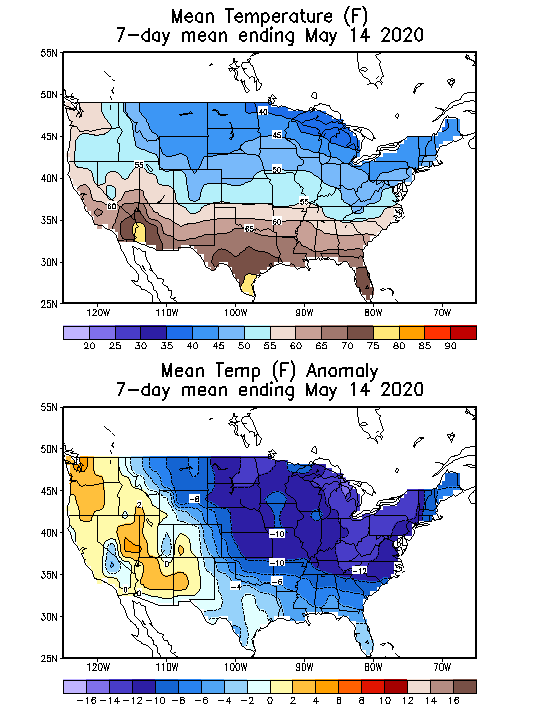
Source: National Oceanic and Atmospheric Administration
Deviation between average and normal (°F)
7-day mean ending May 14, 2020

Source: National Oceanic and Atmospheric Administration

